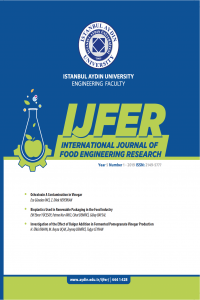CHOCOLATE PRODUCTION, NUTRIENTS AND HEALTH BENEFITS
CHOCOLATE PRODUCTION, NUTRIENTS AND HEALTH BENEFITS
Chocolate is defined as the final product formed by grinding the roasted cocoa
beans with cocoa butter, and sugar and adding emulsifier and vanilla to this
mixture. There are basically three types of chocolate: dark (bitter), milk and
white. Dark chocolate consists of sugar, cocoa butter, and cocoa liquor. Milk
chocolate consists of the same ingredients as dark chocolate but contains milk
(milk powder). White chocolate, on the other hand, consists of sugar, cocoa butter
and powdered milk, but no cocoa liquor. In this article dark chocolate production
processes such as mixing and thinning, conching and tempering were
investigated. Recent studies on nutrients and health benefits of chocolate were
discussed as well.
Keywords:
Chocolate, Thinning, Conching, Tempering, Health benefits, Chocolate, Thinning, Conching, Tempering Health benefits, ,
___
- [1] Tokuşoğlu, Ö. (2015). Kakao Çikolata ve Çikolatalı Ürünler Bilimi ve Teknolojisi. Sidas yayınları, pp.232.
- [2] Schwan, R. F. & Wheals, A. E. (2004). The microbiology of cocoa fermentation and its role in chocolate quality. Critical Reviews in Food Science and Nutrition, 44(4), 205-221.
- [3] Munoz, M. S., Cortina, J. R., Vaillant, F. E., & Parra, S. E. (2020). Critical Reviews in Food Science and Nutrition, 60(10), 1593-1613.
- [4] De Vuyst, L., and S. Weckx, S. (2016). The cocoa bean fermentation process: From ecosystem analysis to starter culture development. Journal of Applied Microbiology, 121(1), 5-17.
- [5] Afoakwa, E. O., Quao, J., Takrama, J., Budu, A. S., & Saalia, F.K. (2013). Chemical composition and physical quality characteristics of Ghanaian cocoa beans as affected by pulp pre-conditioning and fermentation. Journal of Food Science and Technology, 50(6), 1097-1105.
- [6] Türk Gıda Kodeksi Kakao ve Çikolata Ürünleri Tebliği, T.C. Resmî Gazete, 30229, Tebliğ No: 2017/293, Kasım 2017.
- [7] Afoakwa, E. O., Paterson, A., & Fowler, M. (2007). Factors influencing rheological and textural qualities in chocolate – a review. Trends in Food Science and Technology, 18(6), 290-298.
- [8] Konar, N., Özhan, B., Artık, N., Dalabasmaz, S., & Poyrazoglu, E. S. (2013). Rheological and physical properties of Inulin-containing milk chocolate prepared at different process conditions. CyTA- Journal of Food, 12(1), 55-64.
- [9] Afoakwa, E. O., Paterson, A., Fowler, M., & Vieira, J. (2009). Influence of tempering and fat crystallization behaviours on microstructural and melting properties in dark chocolate systems. Food Research International, 42(1), 200- 209.
- [10] Rousseau, D. (2016). Microstructural Imaging of Chocolate Confectionery. In: Imaging Technologies and Data Processing for Food Engineers. (pp. 311- 333). Springer, Cham.
- [11] Beckett, S. T. (2008). The science of chocolate (2nd ed.). London, UK: Royal Society of Chemistry.
- [12] Garti, N., & Aserin, A. (2012). Effect of Emulsifiers on Cocoa Butter and Chocolate Rheology, Polymorphism, and Bloom. In Cocoa butter and related compounds (pp. 275–305). AOCS Press.
- [13] Torres-Moreno, M., Torrescasana, E., Salas-Salvadó, J., & Blanch, C. (2015). Nutritional composition and fatty acids profile in cocoa beans and chocolates with different geographical origin and processing conditions. Food Chemistry, 166, 125-132.
- [14] Fernández-Murga, L., Tarín, J. J., García-Perez, M. A., & Cano, A. (2011). The impact of chocolate on cardiovascular health. Maturitas, 69(4), 312–321.
- [15] Fanton, S., Cardozo, L. F. M. F., Combet, E., Shiels, P. G., Stenvinkel, P., Vieira, I. O., Narciso, H. R., Schmitz, J., & Mafra, D. (2021). The sweet side of dark chocolate for chronic kidney disease patients. Clinical Nutrition, 40, 15–26.
- [16] Wollgast, J., & Anklam, E. (2000). Polyphenols in chocolate: is there a contribution to human health? Food Research International, 33(6), 449–459.
- [17] Fanton, S., Cardozo, L. F. M. F., Combet, E., Shiels, P. G., Stenvinkel, P., Vieira, I. O., Narciso, H. R., Schmitz, J., & Mafra, D. (2021). The sweet side of dark chocolate for chronic kidney disease patients. Clinical Nutrition, 40, 15–26.
- [18] Jackson, S. E., Smith, L., Firth, J., Grabovac, I., Soysal, P., Koyanagi, A., Hu, L., Stubbs, B., Demurtas, J., Veronese, N., Zhu, X., & Yang, L. (2019). Is there a relationship between chocolate consumption and symptoms of depression? A cross‐sectional survey of 13,626 US adults. Depression and Anxiety, 36(10), 987–995.
- [19] Al Sunni, A., & Latif, R. (2014). Effects of Chocolate Intake on Perceived Stress: A Controlled Clinical Study. International Journal of Health Sciences, 8(4), 397–406.
- ISSN: 2149-5777
- Başlangıç: 2015
- Yayıncı: İstanbul Aydın Üniversitesi
